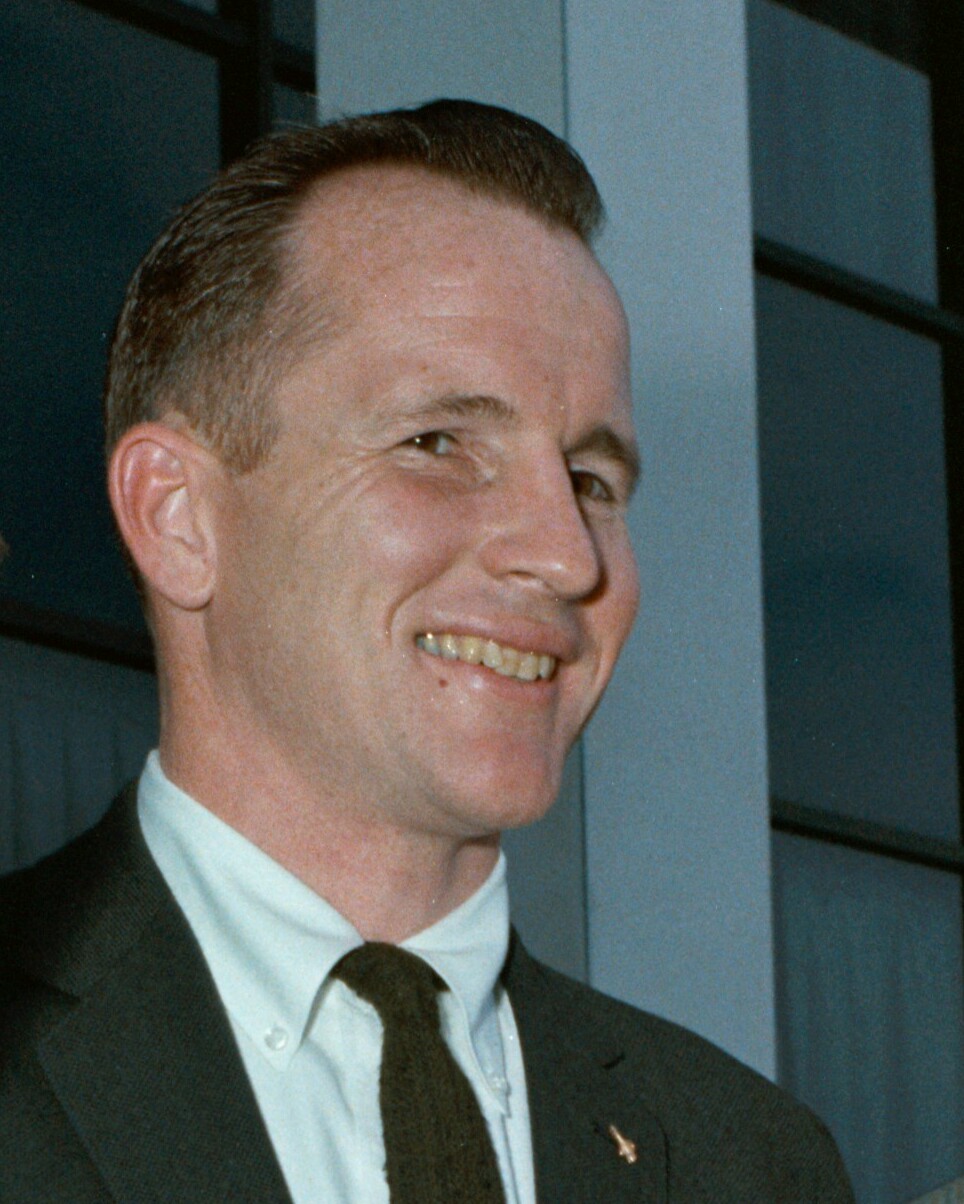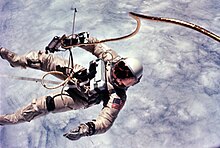Edward Higgins White
| Edward White | |
|---|---|

|
|
| Country: | USA |
| Organization: | NASA |
| selected on | 17 September 1962 (2nd NASA Group) |
| Calls: | 1 space flight |
| Begin: | June 3, 1965 |
| Landing: | June 7, 1965 |
| Time in Space: | 4 days 1 hour 56 minutes |
| EVA inserts: | 1 |
| Total EVA Duration: | 36 mins |
| retired on |
January 27, 1967 Death on Apollo 1
|
| spaceflights | |
|
|
Edward Higgins "Ed" White II ( November 14, 1930 San Antonio , Texas – January 27, 1967 Cape Canaveral Air Force Station , Florida ) was the second human and first United States astronaut , after Alexei Archipovich Leonov , to do so floating freely in space .
Life
Ed White was exposed to airplanes at an early age through his father, who was a West Point graduate and US Air Force pilot . At the age of twelve, his father took him on board a T-6 training plane and allowed him to take the controls during flight. Ed White never forgot this experience for the rest of his life.
Because his father was a highly decorated career officer, Ed White became acquainted with many different military bases around the country. But when he tried to enroll in the high school of his choice in Washington, DC , lack of a permanent home proved to be an obstacle. But he managed to graduate from school and, after finding several advocates, was able to attend the US Military Academy at West Point like his father .
At West Point, White did not only attend to his academic studies. He was an excellent hurdler and broke the West Point record in the 400m hurdles. He narrowly missed out on being nominated for the 1952 Olympics . He was also a big name on the soccer team as a defender.
During a sports tournament, he met Patricia Eileen Finegan, who soon became his wife.
In 1952, Ed White graduated with a bachelor's degree in science and then transferred to the US Air Force. After earning his pilot's license , he was posted to West Germany, where he graduated from the Air Force School in Bad Tölz . There he flew the F-86 Saber jets as well as the newer F-100 fighter jets.
In 1957, Ed White read a newspaper article that talked about the future generation of astronauts. This was the triggering moment that made him steer his career in exactly this direction.
After three and a half years, the White family, now with two children (Edward and Bonnie Lynn), returned to the United States from Germany. To set himself apart a little from the other applicants for the astronaut job, White attended the University of Michigan . In 1959 he earned his master's degree in aeronautical engineering.
From the Air Force to NASA
After the seven Mercury astronauts were unveiled to the public, it was clear to White that serving as an Air Force test pilot was a requirement. He immediately enrolled at Edwards Air Force Base for test pilot training, which he completed in 1959. He then worked at Wright-Patterson Air Force Base in Ohio . He tested the latest weapon systems, wrote technical manuals and helped with the further development of aircraft construction.
Ed White also had the honor of flying the planes used to prepare the Mercury astronauts for weightlessness in space. There he met John Glenn and Deke Slayton . But he also flew Ham and Enos, the two chimpanzees who would later launch the Mercury before the astronauts.
In April 1962, when the Gemini program was in the initial phase, NASA advertised the application conditions for a second group of astronauts. Ed White applied and was accepted.
The training for the Gemini program had been significantly tightened in contrast to the Mercury training. There were now no longer pure passengers of the capsules in demand. The Gemini spaceships had to be controlled and coupled to other spaceships, and spacewalks were also planned. In addition, the prospective astronauts had to familiarize themselves with significantly more carrier rockets, since the follow-up project, the Apollo program , was already being planned. The individual workshops and assembly facilities, as well as the launch pads for the Titan , Atlas , Agena and Saturn rockets were visited one after the other. In addition, scientific training courses were on the program, since research work also had to be carried out during the space flights.
After completing the training, each astronaut had to specialize in a specific area. Ed White was assigned the area of flight control systems, which suited him as an avid test pilot. One of his major innovations was the alignment of all hand controls throughout the Gemini and Apollo systems.
gemini 4
Along with his longtime friend James McDivitt , Ed White was assigned to the Gemini-4 flight. Their flight was to be the first long-duration flight by an American crew to conduct thirteen scientific experiments. In March 1965 two more components were added to the flight plan. McDivitt, as pilot, was to keep the spacecraft equidistant from the second stage Titan rocket in Earth orbit , and Ed White was chosen to perform an EVA. White was to be given a new space suit for his EVA , as well as a control unit that he could hold in his hand. Both were still in development when the Gemini 4 flight plan was announced. NASA only announced White's exit a week before launch.
On June 3, 1965, Gemini 4 took off from Cape Canaveral Air Force Station . Shortly after reaching Earth orbit, it was clear that McDivitt would not be able to keep the spacecraft at the required distance from the Titan rocket stage, as the latter had started to tumble and was not flying exactly on the Gemini 4 orbit coordinates . So the crew concentrated fully on White's EVA.
While the spacecraft was over Hawaii on its third orbit , Ed White opened the hatch and moved out into open space. With his handheld controller, he was able to move around in space with relative ease. He photographed the earth and spacecraft with his 35mm camera, from which McDivitt in turn photographed him. After more than twenty minutes outside the spacecraft, Ed White reboarded the spacecraft.
After a total of 62 orbits, the Gemini 4 landing capsule landed in the Atlantic .
President Lyndon B. Johnson promoted both astronauts to the rank of lieutenant colonel after this successful mission . A confetti parade was held in Chicago in her honor .
gemini 7
Shortly after the completion of the Gemini 4 flight, on July 1, 1965, White was nominated as alternate commander of the long- duration Gemini 7 flight . The flight was conducted in December 1965 without White being used.
AS-204 (Apollo 1)
Ed White's success on the Gemini flight prompted NASA to select him for Apollo 1 .
However, the Apollo spacecraft was not nearly as mature as the previous Gemini model, so the technicians and astronauts worked flat out to complete the first Apollo spacecraft ( S/C 012). As Apollo-Saturn 204 (AS 204), the mission was to take place in the spring of 1967.
A crucial test took place on January 27, 1967 at the launch pad in Cape Canaveral. The entire crew, namely Virgil Grissom , Roger B. Chaffee and Edward H. White, took their places in the command module to perform a plugs-out test . However, during testing (probably from a short circuit or arcing ) the interior of the capsule caught fire. All three astronauts were killed.
White was buried in the United States Military Academy Cemetery (West Point) with a state funeral.
Features and Records
- first American spacewalk ( Gemini 4 )
- along with Virgil Grissom and Roger Chaffee , first fatality in a spacecraft ( Apollo 1 )
- his name is also listed on the metal plate of the Fallen Astronaut , the only piece of art on the moon.
See also
literature
- Edward White , in: International Biographical Archive 07/1967 of February 6, 1967, in the Munzinger Archive ( start of article freely available)
web links
- Short biography of Edward Higgins White at spacefacts.de
- NASA biography by Edward Higgins White (PDF)
- Biography of Edward Higgins White in Encyclopedia Astronautica
- NASA: Streaming video of the EVA ( MPG ; 1.6 MB)
| personal data | |
|---|---|
| SURNAME | White, Edward Higgins |
| ALTERNATIVE NAMES | White, Edward Higgins II; White, Ed |
| BRIEF DESCRIPTION | American astronaut |
| BIRTH DATE | November 14, 1930 |
| PLACE OF BIRTH | San Antonio , Texas , United States |
| DATE OF DEATH | January 27, 1967 |
| PLACE OF DEATH | Cape Canaveral , Florida , United States |




